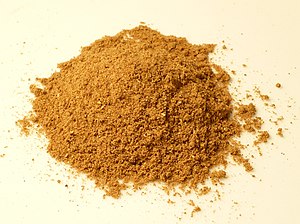 |
| Image via Wikipedia |
A true garam masala mixture is not hot in the way that chili spice mixtures are hot, although it usually is aromatic and pungent. It adds a definite kick to whatever dish it is added to, and its advocates assure us it creates a sense of happiness and well being. It also unmistakably adds a sense of fullness: it makes the consumer feel full.
Like other crucial elements of Indian cuisine, garam masala has been used for centuries and adopted by neighboring nations. Variations of garam masala to suit varying regional cuisines and palates can be found all over southeast Asia. Northern Indian and Punjabi cuisine use large servings of garam masala. Pungent curry mixtures are used in southern India. Most cooks in Pakistan, who are heavily influenced by Punjabi cuisine, also use garam masala in traditional foods.
Garam masala mixes are found in many markets, although most cooks insist that garam masala tastes best when it is made fresh--using spices the cook grew, picked and dried him- or herself. Traditional garam masala includes cumin, nutmeg, cinnamon, black pepper, chili powder, mace, cardamom, fennel, fenugreek, and coriander. Depending on the region, the dish, and the cook, the time of year, the mixture will vary. To prepare garam masala, the spices are ground, then toasted on a hot griddle [called a tava in India]. Pre-ground spices can be used, although are usually not be as pungent. The toasted mixture is used quickly, and any leftovers are tightly sealed and kept for no more than six months.
Unlike other spice mixes and curries, garam masala is usually added at the end of the cooking process so the pungent, spicy flavor survives. It is also added to fried dough and batter to give them an extra note of spicy texture. In both cases, it is used in small quantities because garam masala can be overwhelming in large quantities. Non-Indians may joke, but there are limits to the quantity of spice Indians enjoy per dish.
When India and Asia began to be explored by Europeans, many of the spices used in garam masala were brought to Europe and incorporated into the cuisines of curious nations. Without this addition, native European cooking would be deadly dull. Garam masala makes an excellent dry rub for meat, and can also be used in sauces and marinades. Adventurous cooks might want to experiment with this piquant, flavorful, and flexible spice mixture, which can easily be made to taste at home.

No comments:
Post a Comment